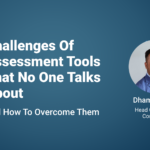
We tend to look for talent in the same old places or follow trends of the “best hire” as the “best fit”. There is no one-size-fits-all approach, but these trends can undermine efforts to boost diversity and hinder creativity and innovation. This article outlines seven challenges that HR teams face when it comes to using psychometric assessments.
Introduction
When building a business, your primary asset is your people. But how do you determine if they are the right fit for the role? That is why psychometric assessments can be a critical tool for your organisation, regardless of levels failing which you can expose your organization to several risks:
- Lower-quality candidates
- Employees without the requisite skills
- Unchallenged, unhappy, or underestimated workforce
- Unreliable backup planning
- High turnover
Any of these obstacles can weigh an organisation down, especially while the demand for talent is stronger than ever. And like any other strategy, there will always be challenges in implementing a successful talent assessment process. This article outlines seven challenges that your HR teams might face when it comes to using talent assessment tools.
Talent Assessments in a Nutshell
The ability to holistically understand an individual, unlock their potential, and determine the right employee for the right role, is crucial to running a top-notch team. As the name implies, talent assessments are tools, such as tests, surveys, interviews, and simulations, that help companies to identify candidates with the best fit, predict a new employee’s work performance, and evaluate their retainability in the long run.
A 2022 Talent Report by Wonderlic showed how crucial talent assessments are in a company’s talent strategy. More than 85% of talent professionals said assessments helped them identify the potential of non-traditional candidates; 84% said assessments helped to quickly identify top candidates, while 83% said assessments can help to reduce turnover.

7 Challenges While Using Assessment Tools

Here are the 7 challenges:
#1. Hassle of dealing with multiple assessment providers
Each assessment tool is fit for purpose, and often organisations end up using multiple tools for different requirements. A low-cost game-based assessment may be more suited for hiring graduates, but for executive leadership, one might prefer a more robust and insightful tool.
On average, organisations use between 3-5 assessment tools, and the problem lies therein. Each vendor onboarded means a different procurement process, with different legal agreements, price negotiations, and time frames, not to mention dealing with multiple stakeholders from each vendor.
All these results in additional tasks for HR, legal, procurement and finance teams, which can add up to significant administrative time commitments while also causing delays in implementing the organizational talent strategy.
#2 High time commitment for learning each tool
There are many different types of talent assessment tools in the market today, such as video interviews, simulations, and psychometrics. It does not stop there as more companies are also considering bringing in various kinds of tests to improve the validity of their talent decisions.
While using assessment tools is an effective way to assess a broad range of candidate skills, learning how to use each one correctly is not without its challenges.
- Technical proficiency – each assessment tool requires users to become familiar with their functional flow, user interface and navigation.
- Training and support – effective use of assessment tools require proper training and support, which can be time-consuming and expensive.
- Reports interpretation – understanding the assessment scores and other talent data can be difficult for users who are unfamiliar with the assessment tool.
#3 Challenges in interpreting reports
Each assessment tool comes with its own unique report, with its jargon, interpretation, and design.
It is a hugely challenging task for HR and managers to get trained in each report, often requiring specialised certification to do so. Every time a new tool is onboarded, a new member joins the HR team, or there is a new manager who needs to utilise the reports, there is a need for additional training.

Assessment reports often use sophisticated technical language and terminology that non-experts may find difficult to comprehend. For example, an assessment report may use terms such as “psychometric validity,” “factor analysis,” or “normative data.” These terms can be confusing and difficult to understand without prior knowledge or explanation.
The assessment data presented can also be complex and subject to different interpretations depending on the context in which they are presented. Finally, assessment tools can create further difficulty when attempting to compare results across different reports.
#4 Consolidating assessment data
Often, assessment scores from multiple tools need to be consolidated for meaningful and convenient analysis. This opens another set of challenges for HR teams, leading to manual analysis of spreadsheets, documents, and presentations.
For instance, to make the right decision, a hiring manager may require results from a psychometric, a simulation, a case study, and an interview. To assist the hiring manager, HR teams must manually combine the different scores and analysis into a consolidated document. Or there may be a need to combine 360 data with a psychometric to take critical decisions around succession planning. To enable this process, HR teams would need to do the consolidation on a spreadsheet, a document, or a presentation.
These are additional tasks for HR teams to deal with because all assessment tools differ in their formats, methodologies, and results, resulting in complexities around:
- Incompatibility of data – different assessments may use different methods, scales, or tools which makes it difficult to compare scores and results.
- Inconsistency in results – different assessments may produce conflicting or inconsistent results, thus making it difficult to reach a clear conclusion.
- Limited information – some assessments may provide limited or incomplete information, making it a hassle to understand the big picture of a person’s strengths and weaknesses.
- Complexity – interpreting multiple assessment reports can be complex and time-consuming, often requiring an elevated level of expertise and knowledge to accurately understand and analyse the results.
It is unsurprising that some managers become resistant to assessments because the output is confusing, or unconsolidated, or that the summary provided does not help them hire better.
#5 Scattered assessment scores and other talent data
As if the task was not hard enough, keeping track of the reports and scores is a challenge, especially for companies with large portfolios. With all the different assessment tools out there, the data gathered tends to be scattered across multiple platforms, files, and folders, turning the process of keeping track into a frustrating endeavour.
Moreover, assessment data needs to be combined with other employee data, especially when dealing with internal talent, thereby creating additional challenges such as:
- Data integration – integrating scattered data from various sources and into different formats can be difficult and time-consuming, requiring significant effort and technical expertise.
- Data accuracy – ensuring the accuracy of data can be challenging, particularly when dealing with large volumes of data from various sources.
- Data security – storing and protecting sensitive data, such as assessment scores, can be a hassle, especially when dealing with sensitive information such as personal health data.
- Data analysis – analysing scattered data and assessment scores can be difficult as it requires advanced technical skills and specialised software to identify patterns and trends.
- Data visualisation – visualising and presenting scattered data and assessment scores in a meaningful and understandable manner can be challenging.
#6 Building a positive candidate experience
When using assessment tools, HR teams must ensure that the candidate experience is as smooth as possible. However, using assessment tools comes with certain challenges that mar the customer experience.
In many situations, they can have a negative impact on the candidate experience. This can include a lengthy or repetitive process, unclear instructions, or unclear evaluation criteria, leading to frustration and decreased engagement from candidates.
Assessments can also be a daunting experience for many, which in turn can impact their scores and their overall perception to work for the company
Additionally, if the results of the assessments are not communicated effectively, or the results are perceived as unfair, it can damage the candidate’s perception of the company and discourage them from applying for future positions.
#7 Speed of rolling out assessment tools
Utilising assessment tools can be a great way to identify individuals with the best skills to fit specific roles; however, their implementation is not always a smooth process.
Each tool has its own roll out process which the users need to learn. Lack of proper training can slow down the rollout process and lead to errors or misuse of the tools, which can lead to inaccurate results or lost data. Without an understanding of the best practices for using each assessment tool, HR teams may spend more time than necessary on the assessment process, thus slowing down the overall hiring timeline. This can lead to missed opportunities and a loss of valuable insights into candidates.
Technical issues involved in the integration of assessment tools can also cause significant delays in the rollout process. Some of the challenges include compatibility problems, slow loading times, system crashes, and an increase in the demand for technical support. When these issues persist, some HR teams may resist using new tools which can lead to delays in their adoption.
A Final Word
Issues such as the above highlight the importance of going with a consolidated approach that provides decision-makers with easier access to information and better decision-making power. It is important to know your business goals, understand what candidates will need to perform on the job, and then deploy the right tools to test and evaluate your applicants.
Talent assessment processes are as varied as they can be complex and complicated. When these tools are used appropriately and effectively, the payoff is a highly efficient recruitment process that can drastically improve the quality of your hires.
To find out more about the various talent assessment tools, read our blog on the Top 25 Talent Assessment Tools in 2023 and the best practices for using these tools.
Page Contents






